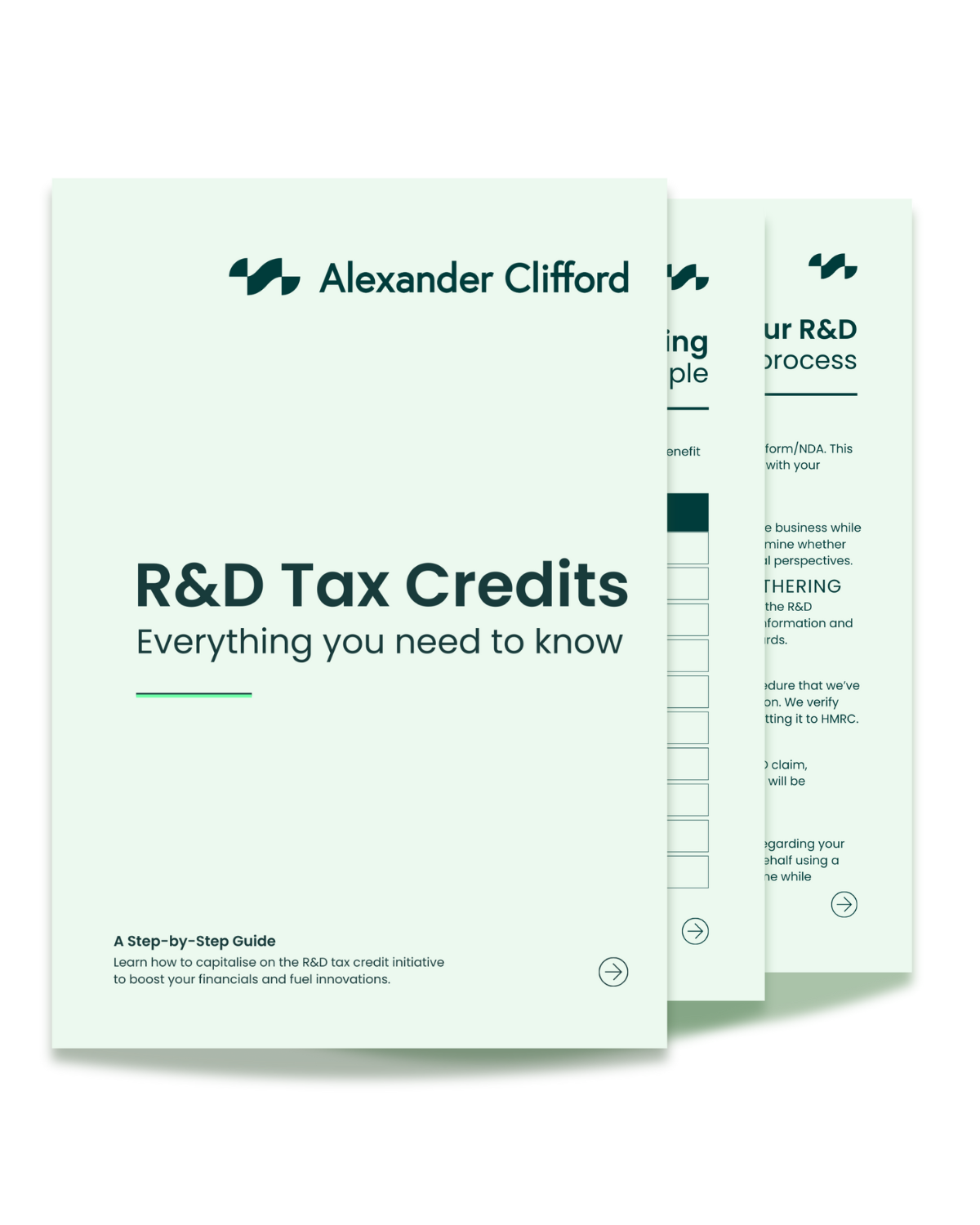Funding Pharmaceutical Innovation with R&D Tax Relief Claims

One thing that society cannot live without is medicine. As requirements and regulations challenge the pharma industry, innovation is a necessity – but with rising costs, is advancement achievable? For UK businesses, a pharmaceutical R&D tax relief claim can ease financial burdens and boost effectiveness. So today we break down what pharmaceutical innovation really means with a look at the history of medicine, emerging trends, and how R&D tax credits can help fund research and development.
While global bodies like the World Health Organization (WHO) implement regulations that aim to improve public health, it’s clear that there’s more to pharmaceutical innovation than breakthroughs in drug development. This inspires pharma businesses to fund ambitious research that pushes the boundaries of medicine.
But let’s be honest, pharmaceutical innovation can get pretty expensive. With research, clinical trials and regulatory approval all contributing to the development of new medicines, the costs quickly add up.
This is where HMRC’s R&D tax relief can help. If your business is based in the UK and has been investing in pharmaceutical innovation, you could qualify for the relief that’s designed to offset the costs of research and development.
So if you’re serious about making the most of your investment in pharmaceutical innovation, keep reading to find out how you can claim UK’s R&D tax credit relief!
What is Pharmaceutical Innovation?
Pharmaceutical innovation incorporates new medicines, therapies and medical devices. The process of innovation can include research and development, clinical trials, and regulatory approval processes. When combined, this process can help bring cutting edge healthcare to market.
The main types of pharmaceutical innovation are:
- Incremental innovation
Improving existing medicines through research and development - Radical innovation
Groundbreaking discoveries that can transform the healthcare industry
Why Innovation in Pharmaceuticals is Necessary
Innovation in pharmaceuticals is necessary to improve treatments for healthcare issues that range from the common cold to chronic illness. By putting patients at the forefront of research and development, the pharmaceutical industry is able to enhance patient care, and improve patient outcomes.
The Impact Innovation has on Healthcare
The patient first approach to pharmaceutical innovation has the ability to provide relief to healthcare organisations around the world.
An example of how innovation impacts healthcare can be seen in the UK with the introduction of weight loss medication. In an NHS (National Health Service) report from 2022/23, data shows that a record 1.2million hospital admissions were obesity related. According to NIH (National Institutes of Health), a single day on a hospital ward costs the NHS an average of £586.59 per patient. That means obesity related admissions cost a minimum £700million in the year 2022/23.
Weight loss medications help facilitate weight loss in patients, ultimately decreasing the risk of obesity related diseases such as diabetes and cardiovascular disease. Based on reporting by the BBC, the administering of weight loss medication will cost the NHS an average of £10billion per year.
While the cost of the weight loss medication makes for half of the NHS’s drug budget, it’s expected that this short term investment in this pharmaceutical innovation will save billions of pounds over the next few years.

A Brief History of the Pharmaceutical Industry
Although pharmacies date back to around 1668, the pharmaceutical industry as we know it didn’t begin until the 1900s, when Heinrich Emanuel Merck mass produced alkaloids in their pure state.
While alkaloids had been used in medicine for centuries, Merck’s process enabled him to manufacture all of the known alkaloids that he then distributed to chemists, pharmacists, and physicians. By mass producing an organic compound used in medicine, Merck became one of the early innovators in the pharmaceutical industry.
Since then, the demand for high quality healthcare has increased, leading to an array of innovations that have transformed the pharmaceutical industry. Some of the greatest pharmaceutical innovations in history are:
- Discovery of penicillin (1928)
Alexander Flemming cultivated the world’s first antibiotic that has been detrimental to fighting off bacterial infections such as pneumonia - Polio vaccine (1955)
Jonas Salk used inactive poliovirus to invoke immunity to the deadly virus that affects young children, pregnant women and the elderly - Implanted pacemaker (1958)
Rune Elmqvist and Åke Senning developed an implantable pacemaker that uses electrical pulses to maintain regular heart rhythms - Monoclonal antibody therapy (1975)
César Milstein and Georges Köhler developed a technique that produces monoclonal antibodies to target specific pathogens - Antiretroviral Therapy (1990’s)
In response to the AIDs epidemic, global organisations collaborated to develop highly active antiretroviral therapy (HAART) to suppress HIV - mRNA vaccines (2020s)
During the global coronavirus pandemic, researchers drew on existing knowledge of messenger RNA (mRNA) technology to develop the COVID-19 vaccine
While these examples highlight some of the most poignant innovations, the pharmaceutical industry is filled with cutting edge advancements that help us to live longer and better lives.
Latest Trends in Pharmaceutical Innovation
As the world is enveloped in the digital age, the rise in medtech has contributed to a rise in pharmaceutical innovation. By combining technology with more traditional methods, the way that medicine works is quickly transforming. These are some examples of the latest trends in pharmaceutical innovation.
AI Technology
AI (artificial intelligence) technology has a variety of applications in medicine. Some of the most prominent uses are:
- Drug discovery and development
- Clinical trial optimisation
- Drug repurposing
- Predictive analytics for disease prevention
- Chatbots and virtual assistants
Precision Medicine
Precision medicine tailors medication to patients based on their genetic makeup, environment and lifestyle. Some of the common applications of precision medicine can be seen in:
- Targeted cancer therapy
- Customised drug response
- Gene therapy targeted at genetic disorders
- Personalised treatment for neurological disorders
- Immunotherapy
- Precision antibiotics
Regenerative Medicine
Regenerative medicine relies on processes that repair, replace or regenerate damaged tissue and organs. Some of the methods being used in regenerative medicine include stem cell therapy, 3D bioprinting, and gene editing (CRISPR).
Challenges Faced in Pharmaceutical Innovation
The human body is a delicate and complex thing which, when combined with strict regulations, can provide various challenges for those pursuing pharmaceutical innovation. Some of these challenges are:
- Rising antibiotic resistance
Due to overuse of antibiotics many types of bacteria are becoming drug resistant, which renders most antibiotics useless - Clinical trial complexities
Clinical trials are complicated, time consuming and expensive, but the biggest challenge is finding a diverse population of test subjects that can help researchers determine the way genetic components interact with the drug - High research and development costs
According to the Association of the British Pharmaceutical Industry, developing a new drug can cost an average of £1.5billion, meaning those invested in pharmaceutical innovation often rely on funding (which can be a challenge in itself)

Funding for Pharmaceutical Innovation
Of course, not all pharmaceutical innovations cost £1.5billion to create. Many SMEs contribute to healthcare with innovations in technology or by building specialised processes – but the cost of research and development can still make innovating a risky business.
For UK based businesses that are investing in pharmaceutical innovation, there are a range of funds designed to support advancements in medicinal science and technology. Some of these funds include:
- Innovate UK grants
- Biomedical Catalyst fund
- National Institute for Health and Care Research fund
- Wellcome Trust grants
- R&D Tax Credits
As each of these funds have different requirements, it’s important to thoroughly research them before your project gets underway. As we’re dedicated to supporting those seeking R&D tax credits, you can find the eligibility criteria below!
Making a Pharmaceutical R&D Tax Relief Claim
When it comes to making a pharmaceutical R&D tax relief claim, there’s one important thing to remember – accuracy is imperative.
The relief is overseen by HMRC who thoroughly analyse claims to ensure that they are compliant with the latest regulations, and a mistake could lead to your claim being escalated to an enquiry.
In order to ensure that your claim is accurate, we recommend that you follow these top tips:
- Keep all research and development related financial information
- Maintain accurate documents that detail your project
- Work with reputable R&D tax credit consultants on your claim
- Understand the eligibility criteria and qualifying costs
By following these tips, you can ensure that your claim is eligible and compliant with HMRC standards.
Eligibility Criteria for Pharmaceutical R&D R&D Tax Relief
R&D claims work by providing tax relief for qualifying research and development projects. This means that claimants must be liable to UK corporation tax. But how can you be certain that your project qualifies?
Qualifying projects must meet the criteria set by HMRC, which is as follows:
“To qualify for R&D relief, your project must seek an advance in a field of science or technology by resolving scientific or technological uncertainty.”
Quote from HMRC Guidance: Check if you can claim research and development (R&D) tax relief
This means that your research and development will qualify for the relief if an expert in the field cannot determine whether what you’re aiming to do is possible.
As your research and development is in the pharmaceutical industry, it is likely that it involves an advancement in science or technology, meaning if you’re aiming to achieve something that few people believe possible, you probably qualify for R&D tax credits.
Qualifying Costs for Pharmaceutical R&D Tax Credits
The qualifying costs for pharmaceutical research and development include:
- Direct staff costs (PAYE, pension, and class 1 NIC contributions)
- Consumables (such as lab equipment and electricity used in R&D)
- Software licence (for software used directly in R&D)
- Externally provided worker (EPW) costs
- Subcontracted R&D costs
- Prototype development costs (for test stage prototypes)
- Clinical trial volunteer costs
- Data licenses
- Pure mathematical related costs (such as PhD level mathematicians)
Make Your Claim With R&D Tax Credit Consultants
At Alexander Clifford, we take pride in our ethical and transparent approach to R&D tax credits, ensuring that every claim is accurate, fully compliant, and maximised to suit your needs. Our commitment to integrity and precision is why our clients consistently rate us a 5 star business for R&D tax credit assistance.
Our team of specialists provides comprehensive support, to carefully assess your projects and identify qualifying costs that are often overlooked. With a meticulous eye for detail, we ensure that you receive every penny you’re entitled to.
That’s why Alexander Clifford is your trusted choice for R&D tax credits.
Don’t leave money on the table. Get in touch today by filling out the contact form below or booking an appointment at a time that suits you. Let’s make sure your business gets the support it deserves.
Book a quick call







